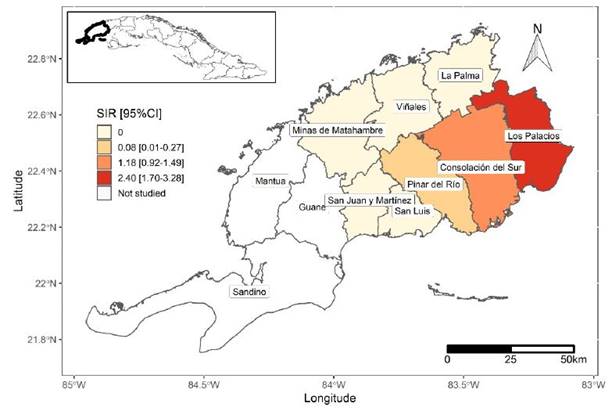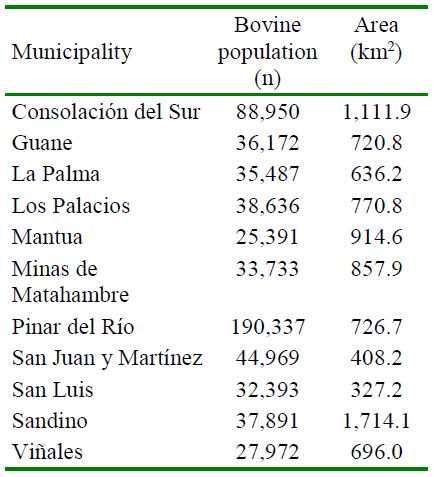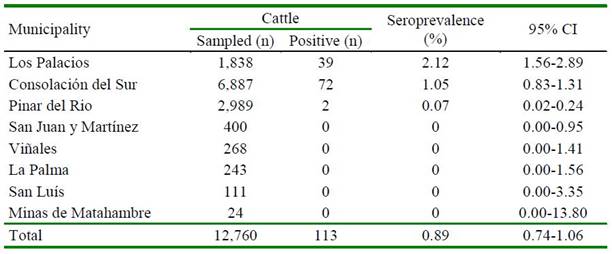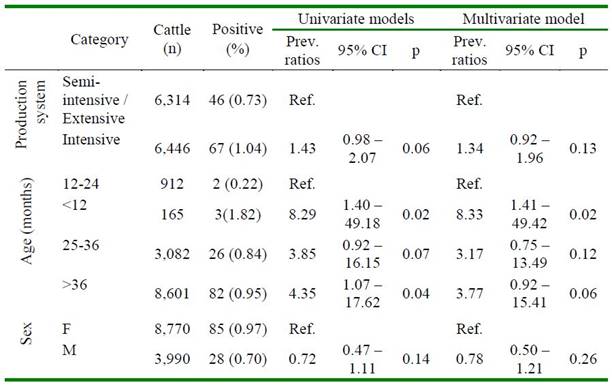INTRODUCTION
Brucellosis is caused by a bacterium of the genus Brucella, which is formed by 11 species differentiated by their antigenic characteristics and their animal host (OIE, 2016). It is a zoonotic infectious disease with worldwide distribution (Beauvais et al., 2016; OIE, 2016), causing reproductive disorders and productive and economic losses (Martínez et al., 2018). The epidemiological situation of the disease varies (Adamu et al., 2016) as it has been eradicated in most industrialized countries (Díaz-Aparicio, 2013); however, the disease is endemic in many developing countries (Márquez et al., 2012; López, 2014; Dorneles et al., 2015). In Latin America and the Caribbean, the prevalence of the disease varies considerably from one country to another (Tique et al., 2016), partially depending on the control and eradication programmes entities (Tique et al., 2009).
Brucellosis in domestic animals is associated with certain risk factors which favour the introduction and presence of the disease in a population (Martínez et al., 2018; Cárdenas et al., 2019). Characteristics such as age, breed, body condition, and sex are highlighted (Makita et al., 2011). It is also associated with certain herd characteristics and production conditions, including abortion history, herd size, insemination method, and farm management practices (Anka et al., 2014; Lindahl et al., 2014).
In Cuba, the first case of brucellosis was detected in 1935 (Cotrina and Fernández, 1991), but the prevention and control programme for this disease was implemented in the 80s. A large part of the national territory was free of the disease due to the effectiveness of the epidemiological measures. However, there were difficulties in controlling the disease since the early 90s and therefore, it remains in some territories of the eastern provinces of the country and other western provinces such as Pinar del Río (Mendoza et al., 2015).
In 2015, Cuba reported a total of 22 outbreaks of bovine brucellosis to the World Organization for Animal Health (OIE). In 2016, the number of reported outbreaks increased to 52 distributed in the provinces of Pinar del Río, Artemisa, Ciego de Ávila, Camagüey, Las Tunas, Holguín, and Granma (OIE, 2013), which indicated a trend towards the worsening of the epidemiological situation in the country. That year, nine outbreaks of bovine brucellosis occurred in Pinar del Río province, plus several cases of brucellosis in humans (ONEI, 2016), mostly associated with human contact with infected cattle or the consumption of contaminated food.
It is highly important to conduct epidemiological studies that help to understand and characterize the disease and thus contribute to its control and eradication. Therefore, the objective of this study was to determine the seroprevalence and geographical distribution of bovine brucellosis in Pinar del Río province and to evaluate its association with possible risk factors.
MATERIALS AND METHODS
Study Area
A cross-sectional study was carried out in Pinar del Río province, the westernmost province of Cuba. The region is bordered by the waters of the Gulf of Mexico and the Caribbean Sea to the north, south, and west, while to the east, it limits with the Province of Artemisa (Figure 1).
Sampling and Diagnostic Methodology
Bovine blood samples were collected during 2019 in eight of the eleven muni- cipalities of Pinar del Río Province (Table 1), as part of the Brucellosis control programme that establishes the monitoring of animals once a year and the slaughter of positive animals.
The blood samples were obtained from the jugular or the coccygeal vein of the animals. In all cases, the owners of the animals signed the informed consent form. A commercial vacuum tube system and disposable needles were used to collect the blood samples. Blood samples were sent in an icepack-cooled container to the provincial laboratory and received within 24 hours after sampling. Samples were centrifuged at 1500 g for 6 min and the serum was transferred in 0.5 ml aliquots to labelled disposable microcentrifuge tubes and frozen at -20 °C.

Figure 1 Map of the Pinar del Rio province (Cuba) showing the standardized incidence ratio per municipality
Sample processing was carried out using the techniques recommended by the OIE (OIE, 2016). The Rose Bengal (RB) test was used as a screening test and Complement Fixa- tion Reaction (CFR) was used as a confirmatory test for samples positive to RB test.
Statistical Analysis
The seroprevalence of brucellosis was calculated according to the formula SP = PA/ IA * 100, where SP = Seroprevalence, PA = Positive animals, and IA = Investigated animals.
The Standardized Incidence Ratio (SIR) was calculated to identify those municipalities with a more unfavourable situation. The number of expected cases (Ei) per municipality was calculated by multiplying the incidence of the disease in the province by the population per municipality. The number of observed cases (Oi) of brucellosis per municipality was divided by the expected cases. Thus, SIR was calculated as SIR= Oi / Ei.
The confidence interval of SIR per municipality was estimated using the epi.conf function of the «epiR» package of the R software (R_Development_Core_Team R, 2018). The hypothesis that SIR is equal to 1 was tested by Byar’s method. Municipalities with an SIR significantly (p<0.05) higher than 1 were considered high risk, and those with an SIR lower than 1 were considered low risk. Geographical representation was carried out using the R statistical program (R_Development_Core_Team R, 2018).
The association between seroprevalence and animal and herd characteristics available in the accompanying information of the sera sent to the laboratory was assessed. Independent variables were, i) system (Semi- extensive / Intensive), ii) sex (F / M), iii) age (<12, 12-24, 25-36, >36 months). The prevalence ratio was calculated using a generalized linear model with a binomial distribution and log link in R (R_Development_Core_Team R, 2018). Univariate and multivariate analyses were performed.
RESULTS
A total of 12 760 bovine samples were analysed and 113 of them were positive, showing a seroprevalence of 0.89% (95% CI 0.74-1.06). The positive cases were distributed in three out of eight municipalities (Pinar del Río, Los Palacios and Consolación del Sur) (Table 2).
Figure 1 shows the map of the study area and the standardized incidence ratio per municipality. Los Palacios municipality had 2.40 (95% CI 1.70-3.28) times more cases than those expected; hence, this ratio was significantly (p<0.05) higher than in the rest of the study area. This municipality can be considered a high-risk area for the occurrence of brucellosis in the bovine population. The incidence of the disease in Consolación del Sur was slightly but not significantly higher than that expected (1.18; 092-1.49). On the other hand, Pinar del Río municipality showed a significantly low SIR of 0.08 (0.01-0.27), and together with the rest of the municipalities studied having no cases, it was considered a low-risk territory.
Univariate analyses (Table 3) showed that sex of animals and farm production systems were not associated with Brucella spp seropositivity to and only age showed a significant association. Although the sex and production system conditions were not significant, both variables were included in the multivariate analysis to estimate the adjusted prevalence ratio. The age range variable showed an association with the dependent variable in both the univariate and multivariate analyses.
In the multivariate model, disease seroprevalence among animals under 12 months of age was 8.33 (1.41-49.42) times higher than in animals between 12 and 24 months (reference category). In addition, the seroprevalence of brucellosis in animals aged between 25 and 36 months (3.17, 0.75-13.49) and animals older than 36 months (3.77, 0.92- 15.41) was also higher, but not statistically significant (p<0.05); however, the latter showed a marginally significant p-value (p=0.064). Furthermore, it should be noted that the prevalence among animals older than 36 months was approximately 1%, while the prevalence in the reference category was only 0.22% (Table 3).
DISCUSSION
The epidemiological situation of brucellosis has been worsening in Cuba since the 80s and 90s due to the aggravation of Cuba’s economic problems, seriously affecting the disease control and eradication programme (Mendoza et al., 2015). The estimated seroprevalence was 0.89%, which, although low, it demonstrates the importance of the disease in the studied region. Similar results were obtained in a previous study conducted in the eastern provinces of the country (Mendoza et al., 2015), which also demonstrated that the number of outbreaks and prevalence of the disease tended to increase. On the other hand, other studies in Brazil (Gonçalves et al., 2009, Borba et al., 2013) reported seroprevalences of 0.16% and %, respectively.
It is widely recognized that multiple factors are associated with the presence of bovine brucellosis in herds (Cárdenas et al., 2019); however, in recent years, Cuba has shown no reports of studies where these factors are referred.
In this study, animals younger than 12 months old were found to have a higher risk of presenting the disease. These results differ from those reported by Apodaca (2004), in which higher seroprevalences were found in adults. Other authors (Walker, 1999; Asmare et al., 2013) pointed out that young animals tend to be more resistant to infection or have less risk of exposure to it, but it is also noted that latent infections can occur (Walker, 1999). On the other hand, Kumar et al. (2016) in India also found higher seroprevalence in young animals.
In Cuba, vaccination is not used as a disease control measure. Hence, positive results in young animals are related to their infection, even directly or from infected mothers. This has been reported in other studies suggesting that in herds where brucellosis is present, there is a considerable risk of infection of young animals, either by consuming colostrum or during the birth of calves from infected mothers (Díaz-Aparicio, 2013). In general, serological diagnosis is only performed in adult animals (Fernández et al., 2018), which may explain the low number of calves examined during the study period. Fernández et al. (2018) recommend the testing of animals at earlier ages in those regions where the risk of infection is high.
The municipalities Los Palacios and Consolación del Sur showed a higher occurrence of the disease than that expected, which may be related to the environmental conditions in which livestock is developed. In these municipalities, located on the southern coast of the province, there are low and muddy soils with the presence of stagnant waters (Estévez et al., 2017) that can favour the transmission of Brucella (Agrocalidad, 2009; Zambrano Aguayo et al., 2016).
The ability of bacteria of the genus Brucella to survive in humid environments for long periods is well known, and climatic variables such as precipitation, temperature, humidity play an important role in the epidemiology of the disease (Aune et al., 2012). In this sense, a previous study carried out in Pinar del Río province in Cuba (Obregón et al., 2015) detected the presence of Brucella spp in the environment in regions where the disease is endemic.
Studies in Brazil have shown that the environmental conditions in breeding areas constitute a risk factor for the occurrence of brucellosis disease (Barbosa da Silva et al., 2014). Studies in African countries such as Ethiopia and Tanzania also demonstrated that the prevalence of brucellosis varies depending on the region and ecosystems (Yilma et al., 2016; Kedir Elemo and Minda, 2018; Sagamiko et al., 2018).
CONCLUSIONS
The seroprevalence of cattle brucellosis at the Los Palacios municipality region was significantly higher than in other municipalities of Pinar del Río province, although Consolación del Sur municipality also deserves special attention.
The age category was associated with the seroprevalence of brucellosis, as animals younger than 12 months showed higher seroprevalence.
The municipality of origin and age category are relevant factors that should be considered by the health authorities to design disease control strategies in the province.












 uBio
uBio 




